A griddle is an essential piece of cookware for every kitchen. A flat cooking surface can be heated to prepare pancakes, eggs, burgers, and grilled cheese sandwiches. Griddles offer the convenience of multiple pans in one appliance, allowing you to cook several items simultaneously. They are also very versatile, as you can use them indoors and outdoors on your stovetop or grill.
The grill is ideal whether you want a savory breakfast or a gourmet dinner. Read on to learn about “what is a griddle” and how it can help simplify your cooking routine.
What Is a Griddle?
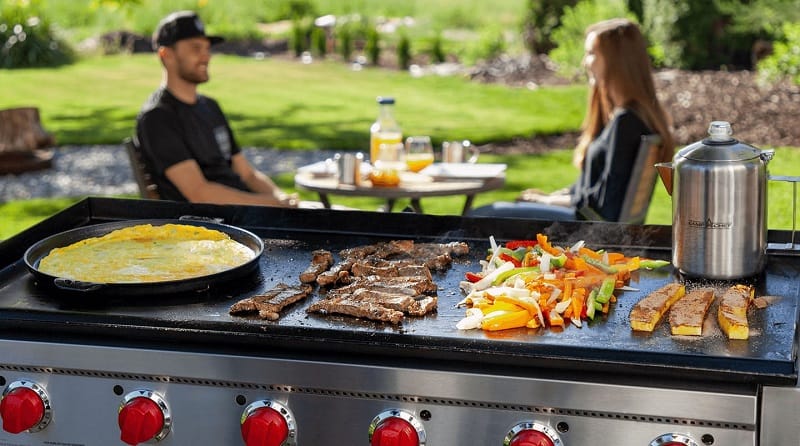
A griddle is a flat surface typically used to cook breakfast foods such as pancakes, bacon, and eggs. Still it can also be used for cooking seafood, meat, vegetables, and even tortillas. It is a large, shallow surface, usually square or rectangular, perfect for flipping food.
Originally, griddles evolved from when ovens were uncommon in homes, and cooks worldwide used flat-top grills made from brick, stone, or clay. Today, griddles are experiencing a resurgence in popularity due to increased home cooking as a result of coronavirus restrictions.
Griddles come in various materials such as ceramic nonstick, aluminum, stainless steel, carbon steel, and cast iron, with cast iron being a popular choice due to its durability and nonstick properties when appropriately seasoned. When choosing a grill, it is essential to consider the size, weight, and type of cooking surface that best suits individual needs.
Types of Griddles
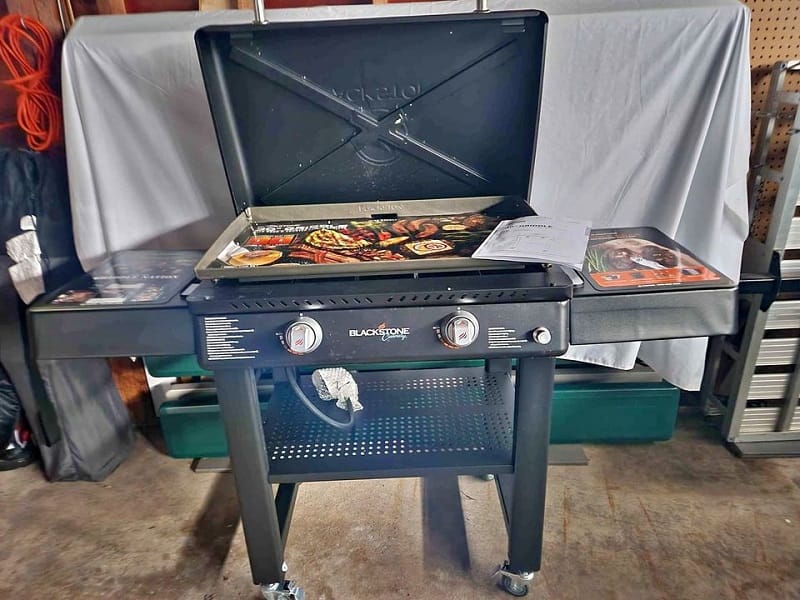
Griddles are incredibly versatile and can be used to cook various dishes. But did you know that there are different types of griddles out there? Here, I’ll share the different griddles you can use in your kitchen.
- Electric Griddles: Electric griddles are perhaps the most popular type of griddles. They are easy to use and come in a range of sizes. Electric griddles are also great because they can be used indoors and outdoors. They are perfect for making breakfast foods such as pancakes, bacon, eggs and other dishes such as grilled cheese sandwiches and burgers.
- Gas Griddles: Gas griddles are similar to electric griddles but use propane or natural gas as a fuel source. They are perfect for outdoor cooking and are often used by professional chefs. Gas griddles are great because they heat up quickly and can be used to cook various dishes.
- Cast Iron Griddles: Cast iron griddles are a classic type of griddle that has been around for centuries. They are great for cooking over a fire or on a stovetop. Cast iron griddles are incredibly durable and can last for generations if properly cared for. They are also great for cooking dishes that require high heat, such as steaks and burgers.
- Ceramic Griddles: Ceramic griddles are a newer type of grill that is becoming increasingly popular. They are made from a ceramic type resistant to high temperatures. Ceramic griddles are great for cooking dishes that require even heat distribution, such as pancakes and crepes.
- Stainless Steel Griddles: Stainless steel griddles are another popular type of griddle. They are great for outdoor cooking and are often used by professional chefs. Stainless steel griddles are incredibly durable and can withstand high temperatures. They are also great for cooking dishes that require even heat distribution, such as pancakes and crepes.
Or classified by the purpose of use, we have these types of grills:
- Outdoor Griddles: Outdoor griddles have become popular due to their ability to add a wonderful smoked flavor to your food. They also provide the convenience of cooking outdoors, saving your home from smells and allowing you to cook at any event, such as hikes or camping trips. Outdoor griddles are easy to clean with a wire brush and paper towel but can rust if not taken care of properly.
- Stovetop Griddles: Stovetop griddles have been around for over a thousand years, making them a popular choice for many people. They are ideal for cooking large amounts of food, with two popular options being the non-stick and cast-iron griddles. They heat up quickly but have the disadvantage of having only two burners, meaning food may cook slower. Cleaning them is simple with hot water and a spatula, but too much soap can lead to rusting.
- Countertop Griddles: When selecting a countertop griddle, it’s essential to consider the size, style, utility type, and plate thickness. Gas griddles are faster to reach temperature and recover and may be a cheaper utility option in some areas. Electric griddles are slower to heat up but can be a great option in areas where gas is unavailable, or electric is cheaper. Drop-in griddles are an excellent choice for hibachi-style cooking, with heating elements located only in the unit’s center. Plate thickness is also necessary, with thinner plates best for breakfast items and thicker plates better for frozen items and meats.
- Chrome Top Griddles: Chrome top griddles are popular for delicate items like eggs and pancakes. They require fewer BTUs to operate, have better heat retention, and create a cooler kitchen environment. Regular steel plates work well for most applications, but thicker plates can store more heat and recover faster when handling large amounts of frozen items.
Read more:
- How To Clean Blackstone Griddle After Cooking
- How To Season A Blackstone Griddle
- Griddle Vs Grill
- Difference Between Bake and Broil
How Does Cooking On A Griddle Compare To Other Cooking Methods In Terms Of Taste And Texture?
Today, I will share my findings on how cooking on a griddle compares to other cooking methods regarding taste and texture.
First, let’s define what a griddle is. A griddle is a flat, smooth surface used for cooking food, usually cast iron or stainless steel. It can be heated over an open flame or an electric or gas stove. Griddles are popular for cooking breakfast foods like pancakes, eggs, and bacon, but they can also be used for cooking various other foods, including burgers, fish, and vegetables.
Now, let’s get to the comparison. Regarding taste, cooking on a griddle provides a unique flavor that cannot be achieved with other cooking methods. This is due to a griddle’s high heat, creating a crispy exterior on the food while retaining its moisture. When cooking on a griddle, the food absorbs the flavors from the oils or seasonings, resulting in a rich, savory taste.
In comparison, cooking on a grill or in an oven can also create a crispy exterior, but the high heat can dry out the food, resulting in a less juicy and tender texture. On the other hand, cooking on a stove or pan can create a more tender texture, but it may not provide the crispy, caramelized exterior that a griddle can achieve.
The texture is another important aspect to consider when comparing cooking methods. Cooking on a griddle provides a unique texture that is crispy on the outside and tender on the inside. This texture is especially desirable for foods like burgers and pancakes, where the contrast between the crispy exterior and tender inside is essential.
Cooking on a grill can also provide a crispy exterior, but the texture may be less tender due to the high heat. Cooking in an oven or stove can provide a more tender texture but may lack the crispy exterior that a griddle can achieve.
Overall, cooking on a griddle provides a unique taste and texture that cannot be achieved with other cooking methods. It is especially desirable for breakfast foods and burgers, where the crispy exterior and tender inside are essential. However, it may not be the best option for all foods, and other cooking methods may be more suitable depending on the desired taste and texture.
How Do You Choose The Right Size Griddle For Your Needs?
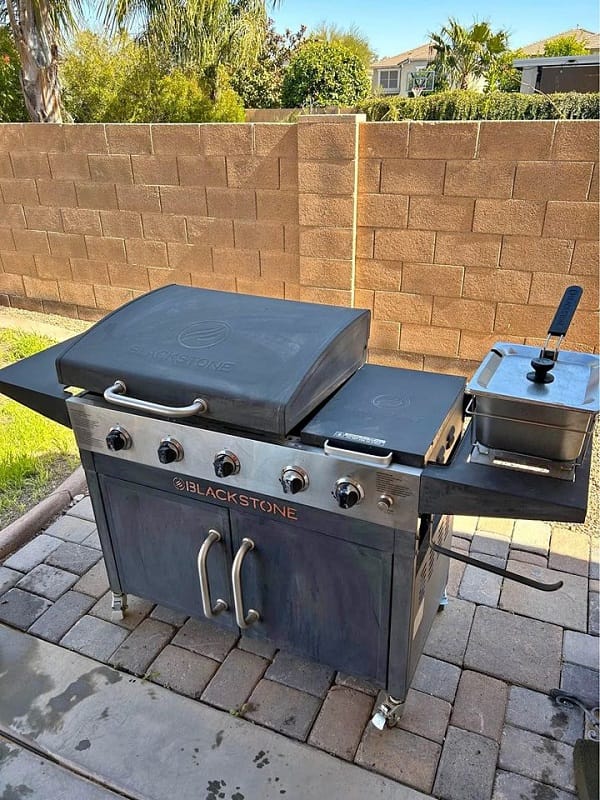
Griddles are versatile, easy to use, and can be used to cook a wide variety of foods. However, with so many different sizes and types of griddles available, it can be difficult to know which one is right for your needs. Here, I will share some tips on choosing the right size griddle for your needs.
First and foremost, consider the size of your cooking surface. You may opt for a smaller griddle if you have a small kitchen or limited counter space. On the other hand, if you have a large family or enjoy entertaining guests, a larger griddle may be more appropriate. It’s important to consider not only the size of the griddle itself but also the size of the cooking surface. A griddle with a small cooking surface may not be suitable for cooking larger items like pancakes or burgers.
Next, think about the type of cooking you plan to do on the griddle. A smaller griddle may be sufficient if you plan to use the griddle primarily for cooking breakfast foods like pancakes, waffles, and eggs. However, suppose you plan to use the griddle for cooking a wider variety of foods, like burgers, hot dogs, and vegetables. In that case, you may consider a larger griddle with a more expansive cooking surface.
Another factor to consider is the heat source you will use. If you plan to use the griddle on an outdoor grill or campfire, you may want to opt for a smaller, more portable griddle. Conversely, if you plan to use the griddle on a stovetop or indoor grill, you may want to consider a larger griddle with a more robust cooking surface.
Finally, consider your budget. Griddles can range in price from under $20 to several hundred dollars. While opting for a cheaper griddle may be tempting, remember that you often get what you pay for. Cheaper griddles may be made of lower-quality materials and may not last as long as more expensive models. However, that doesn’t mean you must break the bank to get a quality griddle. Shop for sales and discounts to find a griddle that fits your budget without sacrificing quality.
Pros Of Griddle
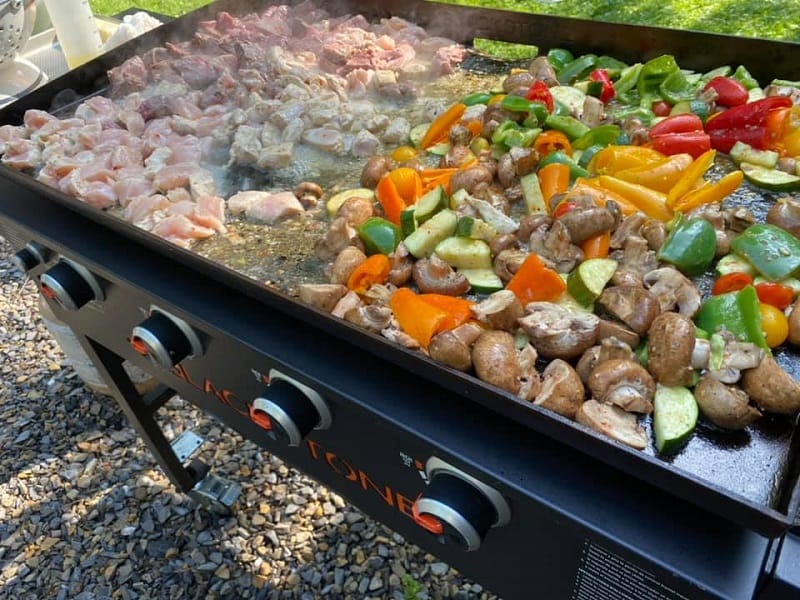
There are so many pros to having a griddle in your kitchen that I cannot imagine not having one. Here, I will say for you10 the advantages of using a griddle in the kitchen.
- Large Cooking Surface: A griddle offers a smooth and rectangular cooking surface that can accommodate large quantities of food or various dishes at once.
- Versatility: Griddles aren’t just for breakfast foods! They can cook almost anything, including searing meat and sautéing vegetables, making muffins, grilled cheese sandwiches, and even pizza.
- Saves Time: With a larger cooking surface, you can cook different dishes simultaneously, reducing cooking time and making it convenient to host family and friends during holidays.
- Easy to Clean: Cleaning is quick and effortless if the griddle is seasoned and maintained properly. After cooking, wipe the surface with paper towels or lint-free cloth, and your griddle is ready for the next cooking session or storage.
- Induction and Gas Operated: Griddles operate using either an induction or gas system, which means they can be used as outdoor and indoor appliances.
- Fat Reduction: Griddles have a slanted surface, which allows any oils or fat to drip off into a grease trap, reducing the fat content in your food.
- Promotes Healthy Cooking: With a well-seasoned griddle or a stainless steel model, no oils are required, or only a small amount if needed, promoting healthy cooking and eating.
- Durability: Griddles are manufactured with sturdy and durable materials and can last for generations if properly cared for and stored in a cool and dry place.
- Even Heating: Once heated up, a griddle retains heat for a longer period, leaving an even, solid, and consistent sear on your food.
- Timeless Cookware: Griddles can be passed down from generation to generation, allowing an enjoyable and memorable cooking experience to be shared with family and friends.
Cons Of Griddle
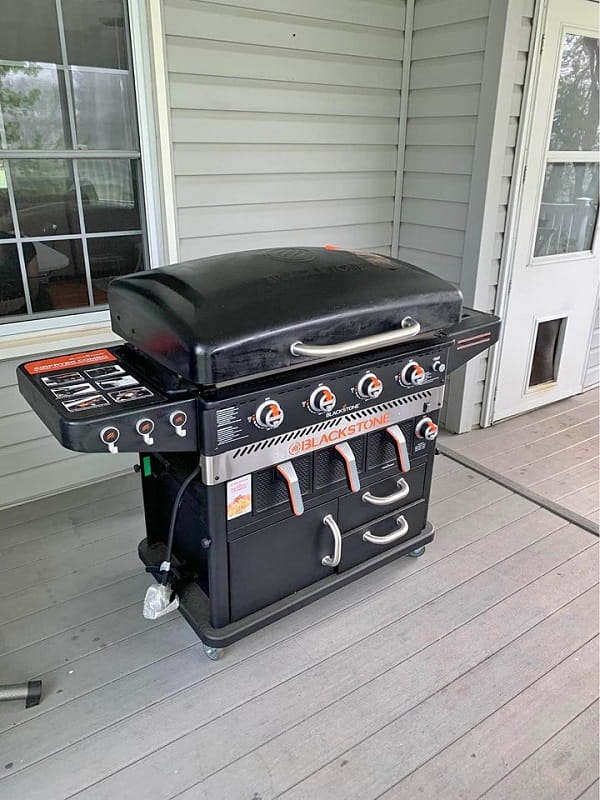
I have also realized that there are some cons to using a griddle, particularly when it comes to safety. I will discuss some of the cons of using a griddle from my point of view.
- Flare-Ups: If not operated with care, griddles can be a fire hazard. Build-up grease is one of the major causes of gas griddle fires. Plus, if you squirt too much grease at once, it can cause flare-ups.
- Burns: Griddles generate a lot of heat, so it’s easy to burn yourself if you don’t pay attention. Keeping a safe distance from the griddle and avoiding grabbing food impulsively without proper equipment is essential.
- Food Poisoning: Griddles can be a breeding ground for bacteria if not cleaned correctly. Cleaning is a must after every cookout to avoid potential food contamination.
- Leaks: Propane griddles require a propane tank, which can be dangerous. You should always check for leaks before usage and use appropriate safety equipment.
- Storage: Proper storage is crucial for any griddle. Pick a room that isn’t damp, has a mild temperature, and protects your equipment from rust damage and heat.
- Operating Under Unfavorable Conditions: Always operate in open spaces away from something flammable, like trees, fencing, or ceilings. Also, never keep flammable materials on the griddle, such as toys, backyard decorations, or plants.
- Safety Issues in Other Machines: Cheap griddles from China can pose multiple safety risks, such as electrocution, metal contamination, and compressor blowouts. It’s essential to do thorough research before purchasing any griddle.
- Lack of Safety Features: Cheap griddles often lack essential safety features such as high and low-pressure switches, fuses, and wiring that meets safety guidelines. Ensuring the griddle you purchase offers all the necessary safety features to avoid potential hazards is crucial.
- Improper Installation: Following the manufacturer’s instructions while installing the griddle is essential. Ensure the griddle is installed correctly while keeping all safety measures in place. Never attempt to install the griddle if you’re not confident of doing it correctly.
- Unsupervised Operation: Griddles should never be left unattended while in use. Always keep an eye on the griddle and ensure that there is adult supervision when kids are around. Staying vigilant can ensure you and your loved ones stay safe while using the griddle.
Tips To Keep In Mind When Using A Griddle At Home?
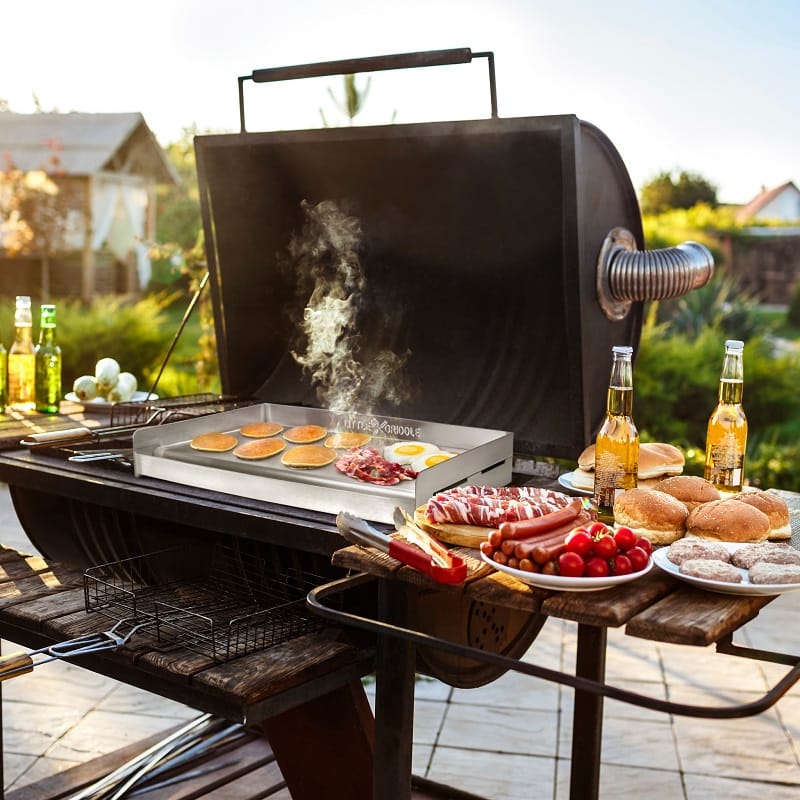
Whether you’re making pancakes for breakfast or cooking up a batch of burgers for dinner, the griddle is a great piece of kitchen equipment to have on hand. However, using a griddle at home can be daunting, especially if you’re not used to cooking on one. That’s why I wanted to share some tips I’ve learned to help make your griddle experience as smooth as possible.
- Preheat your griddle: Ensure your griddle is preheated to the right temperature before cooking. You may need a different temperature setting depending on what you’re cooking. For pancakes, medium heat works well, while burgers may require higher heat. Preheating your griddle will ensure that your food cooks evenly and you get a nice sear outside.
- Use the right tools: When cooking on a grill, it’s important to use the right tools to avoid scratching the surface. Metal utensils can damage a non-stick griddle, so opting for plastic or silicone utensils instead is best. A spatula and tongs are essential tools when cooking on a griddle.
- Don’t overcrowd the griddle: While cooking as much food as possible at once may be tempting, overcrowding can cause your food to cook unevenly. Leave enough space between each item to allow for even cooking and flipping. You can always cook in batches if necessary.
- Keep it clean: After cooking, cleaning your griddle correctly is important to avoid any residue buildup. Allow the griddle to cool before wiping it with a soft cloth or sponge. If there’s any stuck-on food, use a non-abrasive scrubber to remove it gently. Avoid harsh chemicals or steel wool as they can damage the griddle’s surface.
- Experiment with different recipes: One of the best things about cooking on a griddle is how versatile it is. Don’t be afraid to experiment with different recipes and cooking methods. The possibilities are endless, from breakfast foods like pancakes and eggs to dinner favorites like burgers and grilled cheese sandwiches.
The Difference Between a Grill and Griddle
A griddle and a grill are two different cooking surfaces that are often confused. The main difference between a griddle and a grill is the cooking surface. A griddle is a smooth, flat metal cooking surface heated from underneath, while a grill has a series of slatted grates spread about half an inch apart over a heat source.
A griddle receives heat underneath, resembles a big frying pan without a handle or sides, and food cooks directly on it. Griddles are mostly rectangular and come in different sizes depending on the intended use. On the other hand, a grill exposes food cooking upon it to an open flame and uses higher temperatures than a griddle cooking. The heat transfers from the fire directly and through the metal of the grill grate, which absorbs and intensifies the heat, browning or burning at the point of contact.
These cooking surfaces are suitable for different types of food and require different techniques. It is essential to know which one to use for what kind of food to get your desired outcome.
What Are Some Of The Most Popular Dishes To Cook On A Griddle?
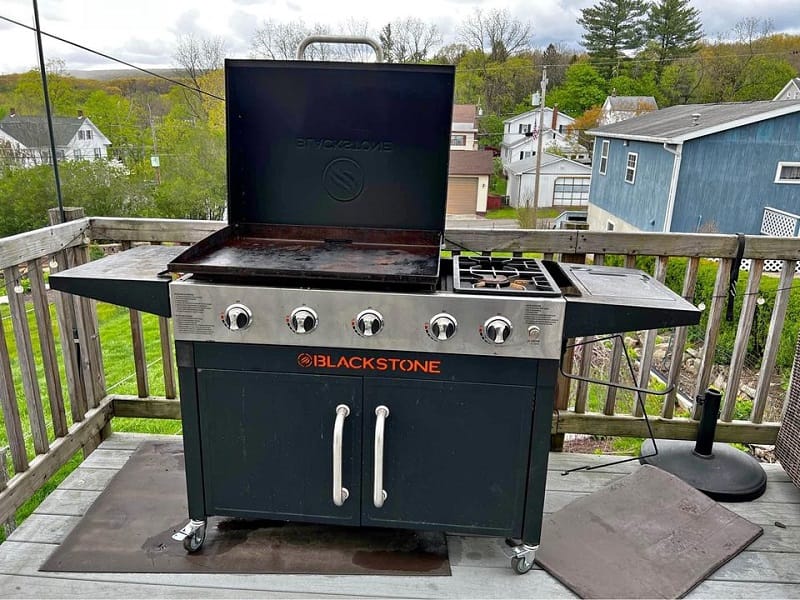
So many dishes can be cooked on a griddle that it can be hard to know where to start. In this blog post, I’ll be sharing some of the most popular dishes to cook on a griddle.
- Pancakes: Pancakes are the most obvious dish to cook on a griddle. Griddles are perfect for making pancakes because they provide an even cooking surface and allow you to cook multiple pancakes at once. Pancakes cooked on a griddle come out fluffy and perfect every time.
- Burgers: Burgers are another popular dish to cook on a griddle. When cooked on a griddle, burgers develop a nice crust on the outside while remaining juicy. Plus, cooking burgers on a griddle allows you to cook multiple burgers without worrying about overcrowding.
- Quesadillas: Quesadillas are a great option for cooking on a griddle because they cook quickly and evenly. Cooking quesadillas on a griddle also allows you to achieve a nice crispy texture on the outside while ensuring that the cheese inside is perfectly melted.
- French Toast: French toast is another breakfast classic that cooks perfectly on a griddle. The even cooking surface of a griddle ensures that the bread is cooked evenly and develops a nice golden brown color. Cooking French toast on a griddle allows you to cook multiple pieces simultaneously, perfect for feeding a crowd.
- Grilled Cheese: Grilled cheese is a classic comfort food that can be perfectly cooked on a griddle. Cooking grilled cheese on a griddle allows you to achieve a nice crispy texture while ensuring that the cheese inside is perfectly melted.
- Stir Fry: Stir fry is a dish traditionally cooked in a wok but can also be cooked on a griddle. The large surface area of a griddle allows you to cook a large amount of food at once, which is perfect for stir fry. Plus, the even surface of a griddle ensures that the food cooks evenly.
- Bacon: Bacon is a breakfast staple that can be cooked to perfection on a griddle. The large surface area of a griddle allows you to cook multiple slices of bacon at once, which is perfect for feeding a crowd. Cooking bacon on a griddle ensures it cooks evenly and develops a nice crispy texture.
How Do You Properly Season A New Griddle?
Properly seasoning a new griddle is essential to protecting it from rust and ensuring a smooth, non-stick cooking surface. Follow these steps and tips for a perfectly seasoned griddle that will last for years to come.
- Preheat the oven to 400 degrees Fahrenheit. This will be necessary to season your new griddle properly.
- Choose an oil with a smoke point of at least 400 degrees Fahrenheit to prevent the oil from catching fire inside the oven. Some good options for oil include canola oil, vegetable oil, and flaxseed oil.
- Wash the griddle with hot soapy water. A new cast-iron pan will have a factory residue, so washing it thoroughly with hot water is essential. This is the only time you should wash your griddle with soapy hot water.
- Dry the griddle completely. Once you have washed your griddle, it needs to be dried completely.
- Rub a thin layer of oil on the griddle surface. With a paper towel or clean cloth, rub a thin and even coating of oil over the surface of the griddle. Use the towel to absorb excess oil to avoid pooling.
- Cook the griddle. Place the oiled griddle in the oven and cook it for forty-five minutes. This is necessary for the oil to form a non-stick surface on the cookware.
- Repeat the oiling and cooking process. Perform the oiling and cooking steps three more times. Use heat-resistant gloves to remove the griddle from the oven each time to apply the next oil coating. Use tongs to hold the oiled paper towel or cloth to avoid burning your hands.
To maintain the seasoning and non-stick surface of the griddle, you should oil the griddle after each use or every cleaning. Then place the griddle on one of the burners of the stove on medium-low heat or in an oven at 200 degrees Fahrenheit for twenty minutes. At a minimum, rubbing a new thin layer of oil on the pan after each use or cleaning should be sufficient to maintain its seasoning.
It is important to use an oil with a high smoke point (the temperature at which the oil will catch fire). Neutral cooking oils such as vegetable, canola, or flaxseed oil work well as they have a high smoke point and will not impart additional flavor to the griddle. Lard or bacon grease can work, but they will go rancid if the griddle sits unused for too long. Beeswax is a longer-lasting option. Refined coconut oil has a 400–450 degrees Fahrenheit smoke point. Unrefined coconut oil and extra-virgin olive oil have very low smoke points and are poor choices for seasoning griddles.
Note:
- Re-season is as necessary. If you ever notice visible rust or charred buildup on the cast-iron pan, wash it as if it’s brand-new and repeat the whole seasoning process.
- Avoid using soap. To maintain your cast-iron griddle’s non-stick surface for as long as possible, steer clear of using soap when washing it. To remove any food buildup or food residue, use a scraper, scouring pad, or special cast-iron cleaning brush. Run the griddle under hot water while scraping, then dry it completely to prevent rusting. Only clean the griddle this way if there is visible food stuck on the griddle. Otherwise, just wipe the pan out with a dry paper towel.
Can You Use A Griddle On An Outdoor Grill?
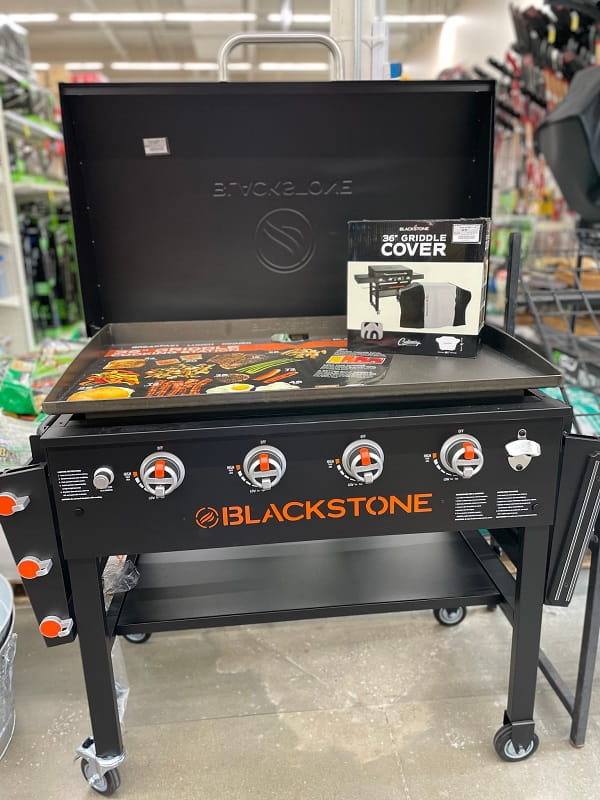
Yes, you can use a griddle on an outdoor grill. Using a griddle on a grill can add extra versatility to your cooking options. A griddle provides a flat cooking surface, which is ideal for cooking foods that might slip through the grates of a traditional grill. Some grills come with a built-in griddle, while others offer insert griddles that can be placed on top of the grill grates.
It’s important to ensure that the griddle is properly sized for your grill and that it is made from a material that can handle high heat, such as cast iron or stainless steel. When using a griddle on a grill, it’s essential to properly preheat the griddle to ensure even cooking and to prevent sticking.
Can You Use A Griddle On A Stovetop, And If So, Which Types Of Stoves Work Best?
Griddles are a popular cooking surface for making breakfast and grilled sandwiches, and they can be used on stovetops. The ideal stove for a griddle has multiple burners that can accommodate the size of the griddle. Gas stoves are particularly well-suited for griddles because of their even heat distribution across the griddle’s surface.
When shopping for a griddle, it’s important to consider factors like the size of the stove, the number of people you plan to cook for, and the type of food you want to cook. Choosing a griddle made of durable, heat-resistant materials like steel or aluminum is also important. With the right griddle and stove, you can enjoy delicious breakfast meals and grilled sandwiches from the comfort of your own kitchen.
Are There Any Health Concerns When Using A Griddle?
When it comes to cooking on a griddle, there are no significant health concerns as long as it is used appropriately. Griddles are known for their convenience and versatility in cooking healthy meals. Cooking on a griddle requires no or less little grease, making it healthy since excess oils and fats in food are unhealthy for the body. Furthermore, griddles typically have non-stick coating/finish surfaces, which means food such as omelets, burgers, vegetables, and steaks hardly stick.
The food cooked on a griddle is healthier because it does not come into direct contact with fire flames, unlike traditional cooking methods such as gas and charcoal grills, which usually produce chemically toxic foods. To ensure healthy griddle cooking, one should watch out for the concentration of Heterocyclic Amines (HCAs) and Polycyclic Aromatic Hydrocarbons (PAHs).
In general, opting for healthy recipes, using fat-free marinades, using a clean griddle, and limiting oil quantities are essential tips to ensure healthy griddle cooking.
How To Properly Clean And Maintain Your Griddle To Ensure It Lasts For Years?
Here’s my step-by-step guide on how to properly clean and maintain your griddle to ensure it lasts for years:
Step 1: Turn off the griddle and let it cool down
Before cleaning your griddle, you need to let it cool down completely. If you try to clean it while it’s still hot, you risk burning yourself or damaging the griddle.
Step 2: Scrape off any excess food and grease
Using a metal spatula, scrape any excess food and grease from the griddle. Be careful not to scratch the surface of the griddle, as this can damage the non-stick coating.
Step 3: Wipe the griddle with a paper towel
Once you’ve scraped off any excess food and grease, wipe the griddle down with a paper towel. This will remove any loose debris and make it easier to clean.
Step 4: Use a griddle-cleaning solution
There are a variety of griddle cleaning solutions available on the market. Choose one that is specifically designed for your griddle’s surface. Apply the cleaning solution to the griddle and let it sit for a few minutes.
Step 5: Scrub the griddle
Using a griddle scrubber, scrub the griddle in a circular motion. Be gentle but firm, and make sure you cover the entire surface of the griddle.
Step 6: Wipe the griddle with a damp cloth
After you’ve scrubbed the griddle, use a damp cloth to wipe it down. This will remove any remaining cleaning solution and debris.
Step 7: Dry the griddle
Once you’ve wiped the griddle down with a damp cloth, use a dry cloth to dry it off. This will prevent any rust or other damage to the griddle.
Step 8: Apply a light coating of oil
To maintain the non-stick surface of your griddle, apply a light oil coating after each use. This will prevent food from sticking and make cleaning easier next time.
FAQs
What Are Some Common Materials Used To Make Griddles?
- Stainless Steel: This is a popular choice for griddles because it is durable and easy to maintain. It is also resistant to rust and corrosion, making it ideal for outdoor use.
- Cast Iron: Cast iron griddles have been around for a long time and are still popular today because of their ability to retain heat evenly. They are also non-stick with proper seasoning and have a rustic charm.
- Steel: Steel griddles are strong and sturdy, and they heat up quickly. They are commonly used in commercial kitchens because of their durability and heat distribution.
- Aluminum: Aluminum griddles are lightweight and easy to clean. They heat up quickly and distribute heat evenly, making them a popular choice for outdoor cooking.
- Ceramic: Ceramic griddles are non-stick and easy to clean. They can be used on a variety of heat sources, including gas, electric, and induction cooktops.
- Copper: Copper griddles are excellent heat conductors, which means they heat up quickly and distribute heat evenly. They also have a beautiful finish that looks great in any kitchen.
- Non-Stick Coated: Non-stick coated griddles are typically made of aluminum or stainless steel and have a non-stick coating that makes them easy to clean and less likely to burn food.
- Titanium: Titanium griddles are known for their durability and strength. They are also non-reactive, which means they won’t affect the taste of the food.
- Composite: Composite griddles are made from a combination of materials, such as stainless steel and aluminum, to create a product that combines the best features of each material. They are lightweight, durable, and heat up quickly.
Are Any Accessories Or Tools Recommended For Use With A Griddle?
Some essential griddle accessories include a cover, which helps protect your griddle’s surface from moisture, debris, and other elements that can cause rust and damage. Cleaning and griddle care accessories such as the Blackstone conditioner and heavy-duty scouring pads are necessary to keep your griddle in fantastic condition.
Another must-have accessory is a set of good-quality tools, including spatulas, tongs, a meat fork, and a serving spoon, all of which make cooking on a griddle more comfortable and enjoyable. To further protect your griddle, you can purchase a hardcover, or for those who like to experiment, a steaming dome can be good for melting cheese or steaming vegetables.
Ultimately, the accessories or tools recommended for use with a griddle depend on the individual’s preferences and the type of griddle being used, but having the right tools can make a huge difference in your cooking results.
Can You Use A Griddle For Cooking On A Camping Trip Or While Traveling?
Using a griddle is an excellent option for cooking on a camping trip or while traveling. A camp griddle is a diverse cooking equipment that can handle breakfast, lunch, and dinner. It is just as good at making bacon and eggs as cooking burgers and hot dogs.
Griddles are typically made of cast iron or have a non-stick surface and are lightweight, easy to carry, and store. Portable griddles can be used over an open campfire or a camping stove with double burners, and there are also standalone units with their own burners built-in and run on propane. With a variety of options available, using a griddle for cooking on a camping trip or while traveling is a convenient and practical choice.
Conclusion
In conclusion, a griddle is a versatile cooking surface that can cook a wide range of foods. They are perfect for cooking large quantities of food, and their even heat distribution makes them ideal for delicate foods like eggs and fish. Whether you’re a home cook or a professional chef, a griddle is a valuable addition to any kitchen. So the next time you’re in the market for a new cooking surface, consider investing in a griddle.
Do you have any questions about what is a griddle? Let us know in the comments below.
References:
- https://www.masterclass.com/articles/how-to-season-a-griddle
- https://www.instructables.com/How-to-Make-an-Outdoor-Griddle/
- https://blackstoneproducts.com/blogs/griddling-tips-tricks/griddle-safety-guide
- https://www.webstaurantstore.com/guide/577/countertop-griddles-buying-guide.html

Hey readers! Chip Holland here, and I’m a Manager of this website. My passion for writing about it only matches my passion for BBQ. Follow my blog for mouth-watering recipes, tips, and tricks for the perfect smoke, grill, and BBQ. I’m sure you won’t be disappointed!
